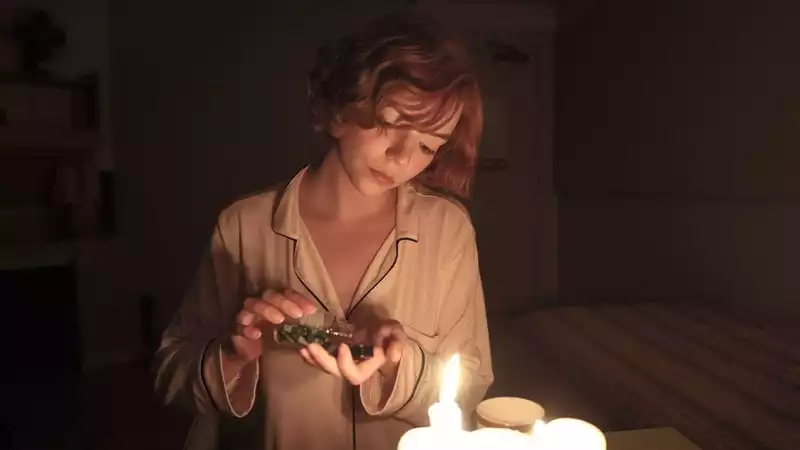
What is the green pill that Beth takes on "The Queen's Gambit"?
WARNING: This story contains spoilers for The Queen's Gambit. Drug addiction is not a new concept in prestige television, but Beth Harmon's substance abuse in Netflix's new miniseries "The Queen's Gambit" (open in new tab) looks quite different from that of her peers in similarly gritty shows. For one thing, the chess prodigy's habit began at an early age, due to the orphanage to which she was sent after her mother's death. For another, throughout most of the series, the drug seems to help rather than hurt Beth in her quest to become a chess grandmaster by "clearing her head" and allowing her to draw a map of the entire game on the ceiling of her room.
It doesn't take long for Beth (played in her younger days by Ira Johnston) to become addicted to the green pill, and it soon becomes clear that the pill is a tranquilizer. And Beth's addiction, which seemed to end with the laissez-faire attitude of the orphanage condoning the administration of drugs to its wards, reappears years later, except for her last-ditch effort to sneak into the medicine room and swallow as many of the remaining, now illegal, pills as she can. Beth's adoptive mother (Marielle Heller) has turned to this drug, which she calls a "tranquilizer," to help her cope with the stress caused by unfulfilled dreams and a failed marriage. Beth, played by Aniya Taylor-Joy (open in new tab), soon begins to suck up a handful of pills for herself and quickly falls back into the agony of addiction.
So what exactly are these orphanage- and mother-approved pills?
In the program, the drug is called zanzolam, which is not a real drug. However, as reported by Newsweek (open in new tab), zanzolam has many striking similarities to chlordiazepoxide, a benzodiazepine that was marketed as Librium. It was all the rage in the 1960s, when "The Queen's Gambit" was set, and came in two-tone green capsules similar to zanzolam. In fact, when Beth runs out of zanzolam while in Mexico City for a chess tournament, she is given Librium at a local pharmacy; patented in 1958 and approved for medical use in 1960, Librium was widely prescribed as a treatment for anxiety, insomnia, and withdrawal symptoms. This widespread use came to a head in the mid-1970s, when the DEA tightened its restrictions on Librium due to its high potential for overprescription and misuse.
These early tranquilizers were reportedly marketed in large quantities to young women and housewives who were physically healthy but struggling to cope mentally, perhaps out of frustration with their position in mid-20th century America. Instead of helping these women to become financially independent or to find high status occupations outside the home, the doctors of the time recommended one sedative after another. Tomite, tomite.
Walter Tevis, who wrote the 1983 novel (open in new tab) on which the Netflix series is based, used his own experiences and used many of his relationships. Beth's addiction to zanzolam was no different; in a 1983 interview with The New York Times, Tevis described how writing about Beth's substance abuse helped him with his own experiences with drug use.
"When I was young, I was diagnosed with rheumatoid arthritis of the heart and was given large doses of drugs in the hospital. That's where Beth's drug addiction came from. Writing about her was a purgative. I dreamed a lot while I was writing that part. But artistically, I wasn't allowed to be self-indulgent. Moreover, benzodiazepine addiction was all the rage in the mid-20th century, but scientists were only able to identify its addictive properties a few years after benzodiazepines were introduced, when dependence and overprescribing were already widespread." (Open in new tab) The National Center on Addiction states, "As with many psychoactive drugs, people soon began to focus on the euphoric effects of taking these common drugs. Whether such abuse is recreational or for therapeutic effects, benzos can cause tolerance, dependence, and addiction.
Sadly, yes, according to a 2018 report by BuzzFeed News (opens in new tab), intravenous sedatives were commonly used to calm children in the abuse that took place in many orphanages in the United States and Canada throughout the mid-20th century The report alleges that the abuse was carried out in a number of orphanages in the U.S. and Canada. In addition, orphanages in countries including Russia (opens in new tab), Ukraine (opens in new tab), and Romania (opens in new tab) have been using IV sedatives to sedate their wards for decades before the time Beth's Kentucky orphanage was ordered to cease doing so in The Queen's Gambit Several reports published in recent years have found the use of powerful drugs.
And as recently as 2018, a federal judge confirmed that government authorities were forcibly injecting tranquilizers into migrant children detained at the border amid ongoing family separations (open in new tab). The judge ordered officials to stop administering psychotropic drugs without parental consent except in emergency cases.
.
Comments